The dehydrated garlic market is experiencing robust growth driven by increasing demand from food processing, seasoning, and convenience food sectors. Rising preference for long-shelf-life ingredients and the growing popularity of ready-to-eat and ready-to-cook meals are supporting steady consumption. Producers are focusing on advanced dehydration techniques that retain flavor, aroma, and nutritional content while optimizing production efficiency.
The market outlook remains positive as food manufacturers and households continue to favor dehydrated garlic for its cost-effectiveness, reduced storage needs, and year-round availability. Global trade expansion, improved supply chains, and rising awareness about garlic’s health benefits are contributing to demand acceleration.
Growth rationale is further strengthened by strong demand from the spice and seasoning industry and the increasing use of dehydrated garlic in sauces, snacks, and processed meat applications These combined factors are expected to sustain market expansion and promote the adoption of innovative product forms catering to diverse consumer and industrial requirements.
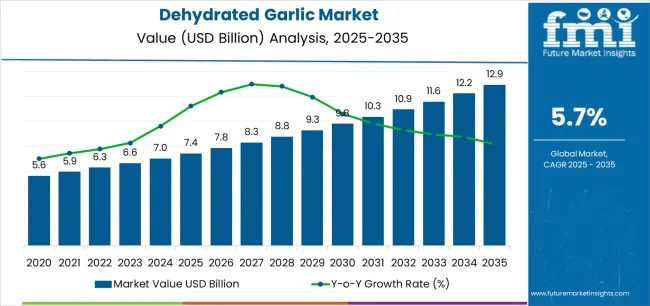
| Metric | Value |
|---|---|
| Dehydrated Garlic Market Estimated Value in (2025 E) | USD 7.4 billion |
| Dehydrated Garlic Market Forecast Value in (2035 F) | USD 12.9 billion |
| Forecast CAGR (2025 to 2035) | 5.7% |
The market is segmented by Variety, Form, Nature, Drying Method, and Sales Channel and region. By Variety, the market is divided into Softneck and Hardneck. In terms of Form, the market is classified into Powder, Chopped, Minced, Granules, Flakes, Kibbled, and Sliced. Based on Nature, the market is segmented into Conventional and Organic. By Drying Method, the market is divided into Air Drying, Spray Drying, Freeze Drying, Drum Drying, and Vacuum Drying. By Sales Channel, the market is segmented into B2B/Direct, Food Service (HoReCa), and Retail/ B2C/Indirect. Regionally, the market is classified into North America, Latin America, Western Europe, Eastern Europe, Balkan & Baltic Countries, Russia & Belarus, Central Asia, East Asia, South Asia & Pacific, and the Middle East & Africa.
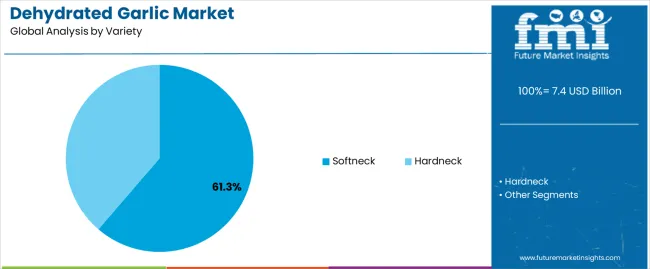
The softneck variety, accounting for 61.3% of the variety category, dominates the market due to its high yield, longer shelf life, and suitability for dehydration. Its uniform bulb structure and stable flavor profile make it preferred by processors for mass production.
The segment’s growth has been supported by consistent cultivation practices, cost efficiency, and adaptability to various climatic conditions. Widespread availability and higher solid content enable better dehydration output, ensuring consistent supply for industrial applications.
Producers continue to focus on optimizing curing and drying methods to maintain quality, aroma, and moisture balance With sustained demand from large-scale food processors and exporters, the softneck variety is expected to maintain its leadership position and drive long-term stability within the dehydrated garlic market.
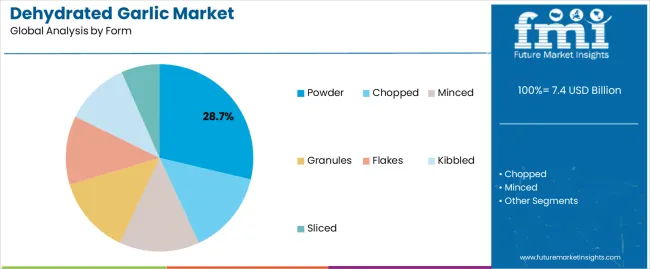
The powder form, holding 28.7% of the form category, has emerged as a key product segment due to its ease of use, uniform dispersion, and extended storage capacity. The segment’s dominance is reinforced by extensive application in processed foods, spice blends, and instant meal formulations.
Powdered dehydrated garlic offers versatility in culinary use and manufacturing convenience, making it a preferred choice among both commercial food processors and retail consumers. Improved grinding and milling technologies have enhanced consistency and flavor retention, while airtight packaging innovations have supported longer shelf stability.
Market participants are emphasizing quality assurance and standardization to meet global food safety norms, ensuring continued demand growth for powdered dehydrated garlic across both domestic and international markets.
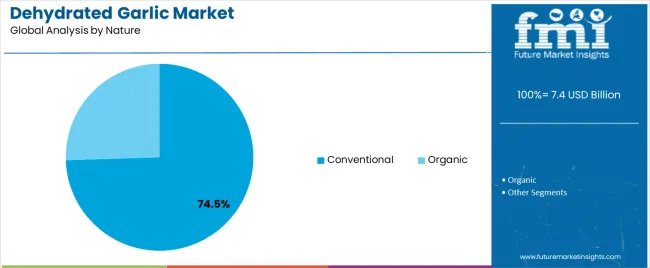
The conventional segment, representing 74.5% of the nature category, leads the market owing to its wide availability, cost competitiveness, and established production base. Large-scale cultivation and processing infrastructure have ensured steady supply at affordable prices, catering to bulk buyers and industrial manufacturers.
The dominance of conventional dehydrated garlic is also attributed to its suitability for high-volume applications such as sauces, ready meals, and seasoning blends. Producers are focusing on maintaining consistent quality through improved drying and sorting techniques while adhering to safety and hygiene standards.
Although the organic segment is gaining gradual traction, conventional products continue to hold the majority share due to strong distribution networks and consumer preference for economically priced ingredients This enduring demand is expected to uphold the segment’s leadership throughout the forecast period.
The historical period they pushed the market through 2025 at a CAGR of 2025. The fundamental driving force for the dehydrated garlic market focuses on garlic’s use to produce different sauces. These sauces were used in numerous dishes and cuisines. Consequently, the popularity of dehydrated garlic increased, which pushed the market.
Apart from this, food chains introduced bold flavors, which surged the demand for garlic, as it provides a tangy taste and flavor to dishes and spices. Therefore, this surged the subject market, pushing it moderately during the historical period.
The forecasted period is estimated to emphasize an individual’s health. Due to the rising prevalence of heart-related issues, preventive measures are preferred. This enhances the importance of garlic, as it possesses excellent medicinal properties that can cure heart-related matters. Therefore, this will be the primary demand for the market.
| Historical CAGR from 2020 to 2025 | 5.30% |
|---|---|
| Forecast CAGR from 2025 to 2035 | 5.70% |
The Indian market has been emerging in the industry, which creates the most lucrative opportunities for the dehydrated garlic market. Similarly, other Asian countries reflect significant growth in the subject market, which propels the Asia-Pacific region to lead the subject market.
North America produces an ever-growing food chain, experimenting with many dishes and cuisines. Consequently, the demand for garlic products increases, surging the subject market.
Apart from this, Europe has also been one of the essential contributors to the subject market.
Forecast CAGRs from 2025 to 2035
| Countries | Forecasted CAGR from 2025 to 2035 |
|---|---|
| The United States | 10.3% |
| Germany | 9.8% |
| China | 10.9% |
| Japan | 8.9% |
| India | 11.8% |
| Category | Variety (Hard neck) |
|---|---|
| Market Share in 2025 | 87.2% |
| Market Segment Drivers |
|
| Category | Form (Powder) |
|---|---|
| Market Share in 2025 | 30.3% |
| Market Segment Drivers |
|
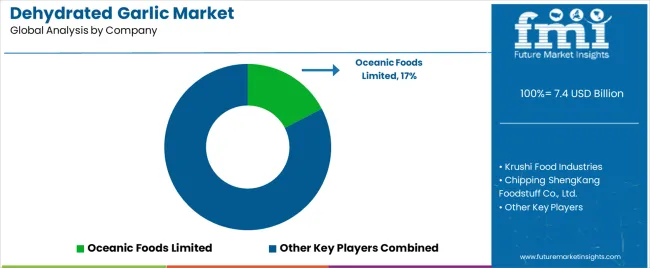
Organizations working in a wider landscape actively participate in the market’s competition. Businesses working in allied industries also play an active role in cluttering the market. A new entrant can create market space through product innovation or diversification.
Marketers expand with numerous strategies, including innovation, franchising, mergers and acquisitions, partnerships, forming subsidiaries, and many other strategic moves.
Key Market Developments
| Attributes | Details |
|---|---|
| Estimated Market Size in 2025 | USD 7.4 billion |
| Projected Market Valuation in 2035 | USD 12.9 billion |
| Value-based CAGR 2025 to 2035 | 5.70% |
| Forecast Period | 2025 to 2035 |
| Historical Data Available for | 2020 to 2025 |
| Market Analysis | Value in USD billion |
| Key Regions Covered | North America; Latin America; Western Europe; Eastern Europe; South Asia and Pacific; East Asia; The Middle East and Africa |
| Key Market Segments Covered | By Variety, By Form, By Nature, By Drying Method, By Sales Channel, Region |
| Key Countries Profiled | USA, Canada, Brazil, Argentina, Germany, United Kingdom, France, Spain, Italy, Nordics, BENELUX, Australia & New Zealand, China, India, ASIAN, GCC Countries, South Africa |
| Key Companies Profiled | Krushi Food Industries; Chipping ShengKang Foodstuff Co., Ltd.; Xuzhou Liming Food Co., Ltd.; Henan Sunny Foodstuff Co., Ltd.; Oceanic Foods Limited; Garlico Industries Ltd.; Royal (Jinxiang) Garlic Co., Ltd.; B. C. Foods (Shandong) Co. Ltd.; V.T. Foods Pvt. Ltd.; Daksh Foods Pvt. Ltd.; Handan Green and Healthy Dehydrated Vegetables Food Co. Ltd. |
The global dehydrated garlic market is estimated to be valued at USD 7.4 billion in 2025.
The market size for the dehydrated garlic market is projected to reach USD 12.9 billion by 2035.
The dehydrated garlic market is expected to grow at a 5.7% CAGR between 2025 and 2035.
The key product types in dehydrated garlic market are softneck and hardneck.
In terms of form, powder segment to command 28.7% share in the dehydrated garlic market in 2025.






Full Research Suite comprises of:
Market outlook & trends analysis
Interviews & case studies
Strategic recommendations
Vendor profiles & capabilities analysis
5-year forecasts
8 regions and 60+ country-level data splits
Market segment data splits
12 months of continuous data updates
DELIVERED AS:
PDF EXCEL ONLINE
Dehydrated Skin Product Market Forecast Outlook 2025 to 2035
Dehydrated Onions Market Analysis - Size, Share, and Forecast Outlook 2025 to 2035
Dehydrated Vegetable Market Analysis - Size, Share, and Forecast Outlook 2025 to 2035
Dehydrated Culture Media Market Analysis - Size, Share, and Forecast 2025 to 2035
Dehydrated Pet Food Market Insights – Premium Nutrition & Market Trends 2025 to 2035
Competitive Overview of Dehydrated Onions Market Share
Market Share Insights of Dehydrated Meat Products Providers
Dehydrated Meat Product Market Growth & Demand Forecast 2025-2035
UK Dehydrated Onions Market Report – Trends, Demand & Outlook 2025–2035
USA Dehydrated Onions Market Insights – Size, Trends & Forecast 2025-2035
ASEAN Dehydrated Onions Market Trends – Size, Demand & Forecast 2025-2035
Korea Dehydrated Vegetable Market Analysis by Product Type, Form, Nature, End Use, Technology, Distribution Channel, and Region Through 2035
Europe Dehydrated Onions Market Analysis – Growth, Trends & Forecast 2025-2035
Australia Dehydrated Onions Market Trends – Size, Demand & Forecast 2025–2035
Demand for Dehydrated Vegetables in EU Size and Share Forecast Outlook 2025 to 2035
Demand for Dehydrated Onions in EU Size and Share Forecast Outlook 2025 to 2035
Latin America Dehydrated Onions Market Outlook – Demand, Share & Forecast 2025-2035
Western Europe Dehydrated Vegetables Market Analysis by Product Type, Form, Nature, End Use, Technology, Distribution Channel, and Country Through 2025 to 2035
Demand of Dehydrated Vegetables in Japan Size, Share, and Forecast Outlook 2025 to 2035

Thank you!
You will receive an email from our Business Development Manager. Please be sure to check your SPAM/JUNK folder too.
Chat With
MaRIA